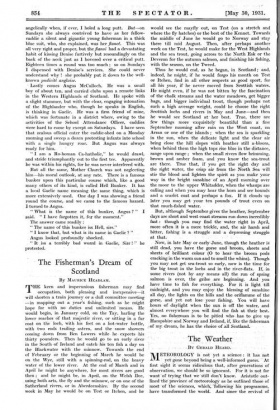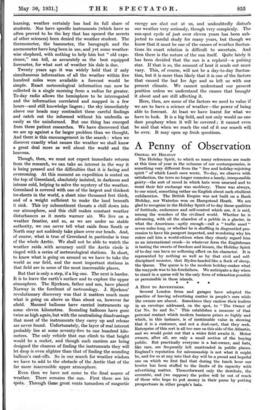The Weather
BY GERALD HEARD. -
M ETEOROLOGY is not -yet a : it "his not . - yet gone beyond being a well-informed gue§s. - At first sight it seems ridichldus that, after generation§ of observation, we shoUld be so ignorant. For it is not for want "of trying that we 'Still don't know. Aristotle out- lined 'the""province of meteorology as he outlined those of most of The Sciences, which; -following' his programme, have transformed the world. And since the revival of learning, weather certainly has had its full share of students. Nor have specific instruments (which have so often proved to be the key that has opened the secrets of other sciences) been denied the weather student. The thermometer, the barometer, the barograph and the anemometer have long been in use, and yet some weather- wise shepherd, with nothing to help him but " old expe- rience," can tell, as accurately as the best equipped forecaster, for what sort of weather his dale is due.
Twenty years ago it was widely held that if only simultaneous information of all the weather within five hundred miles were available a forecast would be simple. Exact meteorological information can now be collected in a single morning from a radius far greater. To-day radio allows the hemisphere to be interrogated and the information correlated and mapped in a few hours—and still knowledge lingers ; the sky immediately above our heads may contradict these careful findings and catch out the informed without his umbrella as easily as the uninformed. But one thing has emerged from these patient researches. We have discovered that we are up against a far larger problem than we thought. And there is this encouragement in the search ; when we discover exactly what causes the weather we shall know a great deal more as well about the world and the heavens.
Though, then, we must not expect immediate returns from the research, we can take an interest in the way it is being pressed and the difficulties that it is facing and overcoming. At this moment an expedition is seated on the top of Greenland, absolutely isolated, in darkness and intense cold, helping to solve the mystery of the weather. Greenland is covered with one of the largest and thickest ice-sheets in the world, a sheet nine thousand feet thick, and of a weight sufficient to make the land beneath it sink. This icy subcontinent thrusts a chill down into our atmosphere, and this chill makes constant weather disturbances as it meets warmer air. We live on a weather frontier, and so, as we are under no stable authority, we can never tell what raids from South or North may not suddenly take place over our heads. And, of course, what is true of Greenland in particular is true of the whole Arctic. We shall not be able to watch the weather raids • with accuracy until the Arctic circle is ringed with a series of meteorological stations. In short, to know what is going on around us we have to take the world as our field, and the most important stations in that field are in some of the most inaccessible places.
But that is only a step, if a big one. The next is harder. It is to leave the earth's surface and to explore the upper atmosphere. The Bjerknes, father and son, have placed Norway in the forefront of meteorology. J. Bjerknes' revolutionary discovery was that it matters much more what is going on above us than about us, however far afield: Manned balloons have carried instruments up some eleven kilometres. Sounding balloons have gone twice as high again, but with the neutralizing disadvantage that most of the instruments they carry up and release are never found. Unfortunately, the layer of real interest probably lies at some seventy-five to one hundred kilo- metres. The only ,vehicle that can climb to that height would be a rocket, and though such carriers are being designed the chances of finding the instruments they will let drop is even slighter than that of finding the sounding balloon's cast-offs. So in our search for weather wisdom we have to add to the obstacle of the Arctic that of the far more inaccessible upper atmosphere.
Even then we have not • come_ to the . final source of weather. There remains the sun. First there are his spots. Through these great, vents tornadoes of magnetic energy are shot out at us, and undoubtedly disturb our weather very seriously, though very complexly. The sun-spot cycle of just over eleven years has been sub- jected to careful study for many years, but though we know that it must be one of the causes of weather fluctua- tions its exact relation is difficult to ascertain. And then there is the nature of the sun itself. Quite lately it has been decided that the sun is a cepheid—a pulsing star. If that is so, the amount of heat it sends out must vary. This, of course, will not be a day-to-day fluctua- tion, but it is more than likely that it is one of the factors that caused the last Ice Age and so left us with our present climate. We cannot understand our present position unless we understand the causes that brought it about and are still affecting it.
Here, then, are some of the factors we need to value if we are to have a science of weather—the power of being able to forecast. At least we have learnt for what we have to look. It is a big field, and not only would no one dare prophesy when it will be covered ; it cannot even be said that when we reach the end of it our search will be over. It may open up fresh questions.







































 Previous page
Previous page